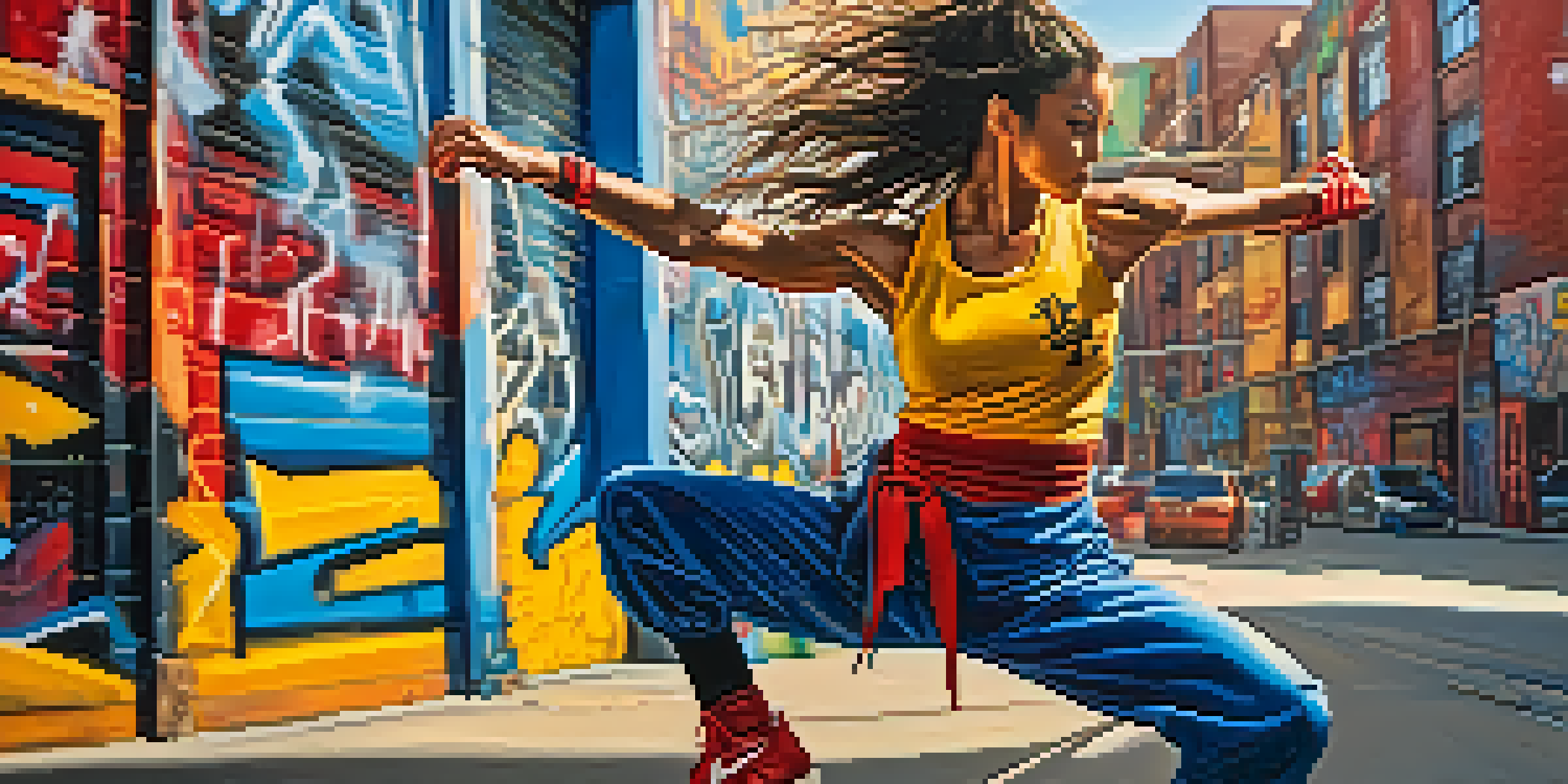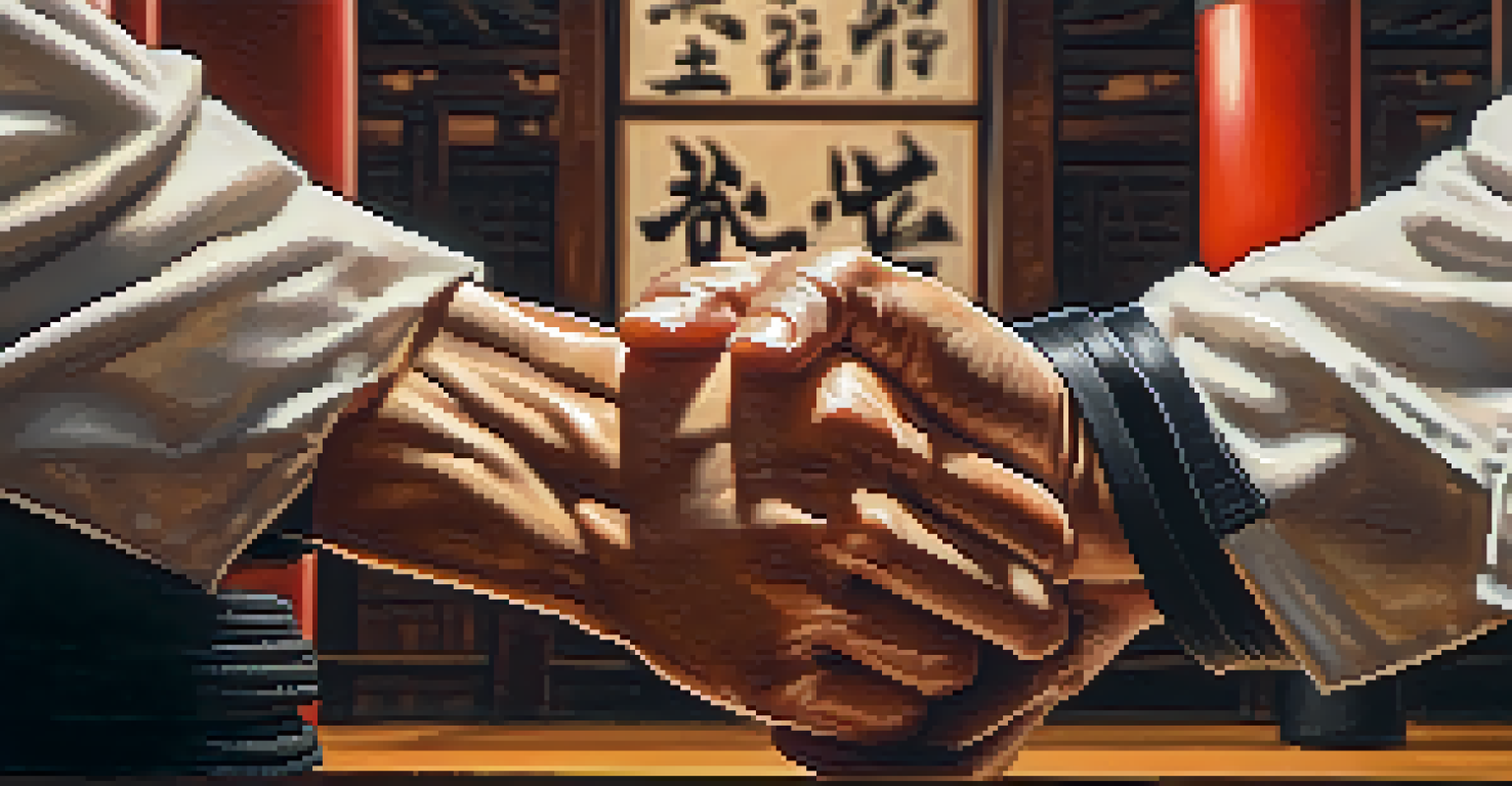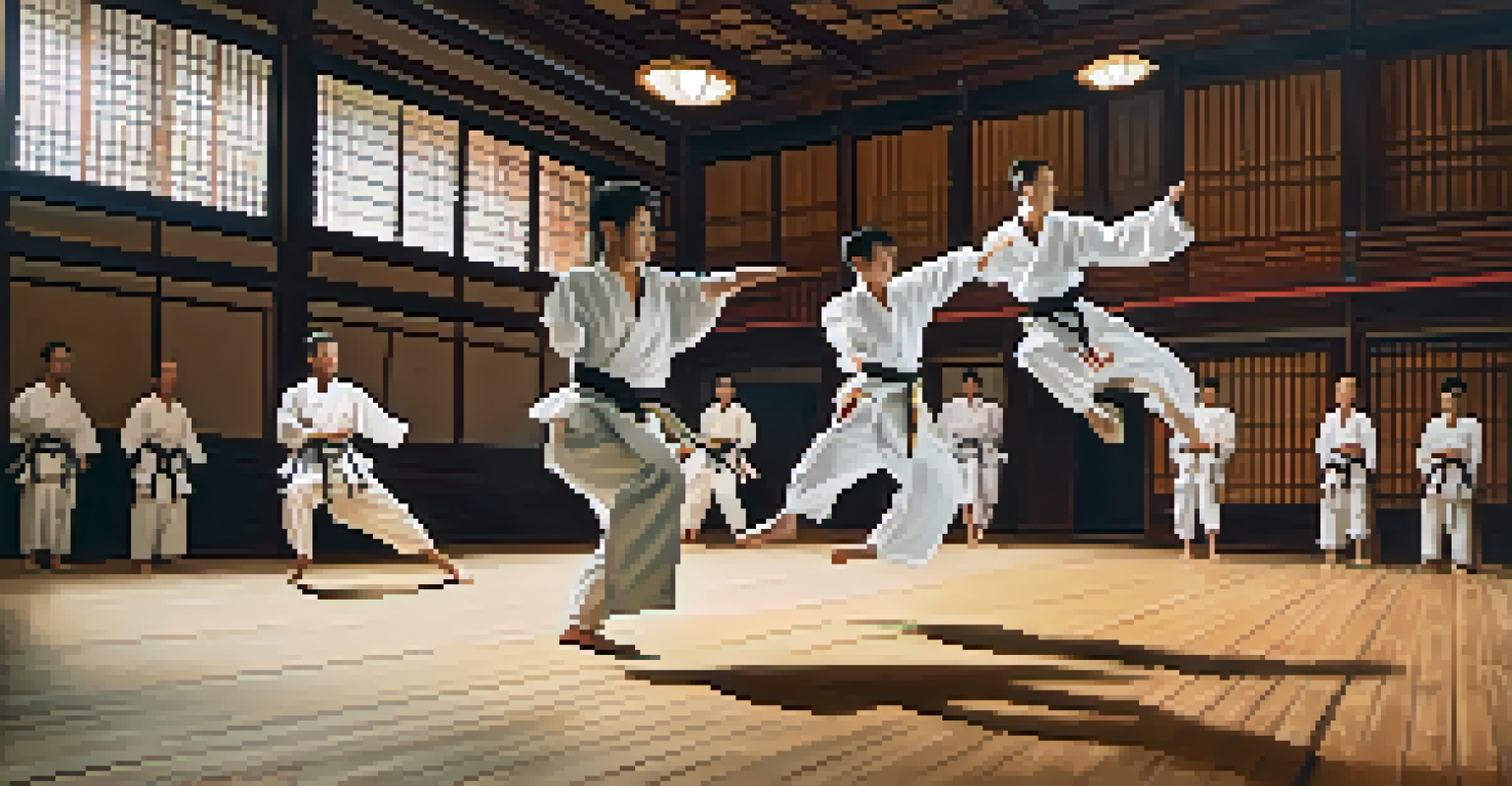Martial Arts in Music Videos: A Dance of Action and Style

The Rise of Martial Arts in Music Videos
In recent years, martial arts have made a significant impact on music videos, transforming them into visual spectacles. Artists are increasingly incorporating choreographed fight scenes that not only entertain but also tell a story. This trend reflects a broader cultural fascination with martial arts, stemming from popular films and television shows that have showcased these skills.
Dance is the hidden language of the soul.
As musicians seek to stand out in a crowded market, the use of martial arts in their videos serves as a unique selling point. The blend of music and movement creates an engaging experience that captivates viewers. Think of iconic videos like 'Smooth Criminal' by Michael Jackson, where dance moves resemble martial arts techniques, setting a precedent for future artists.
Moreover, martial arts can symbolize strength, empowerment, and resilience, themes that resonate deeply with audiences. By integrating these elements, artists can convey profound messages while keeping their performances visually appealing. This combination ensures that martial arts remain a staple in the evolving landscape of music videos.
Choreography: The Heart of Martial Arts in Music Videos
Choreography is crucial when blending martial arts with music, as it dictates the flow and intensity of the performance. Skilled choreographers often work alongside artists to create a seamless integration of movements that enhances the overall impact of the video. This collaboration ensures that both the music and martial arts elements complement each other beautifully.

For instance, in videos like 'Baddest Man Alive' by The Black Keys and RZA, the martial arts choreography is not just an addition but a vital part of the narrative. Each punch, kick, and flip is meticulously planned to align with the beat and rhythm of the song. This synchronization creates a captivating viewing experience that keeps audiences engaged.
Martial Arts Enhance Music Videos
The integration of martial arts in music videos creates engaging visual narratives that resonate with audiences.
Moreover, choreographed fight scenes often borrow techniques from various martial arts styles, adding diversity and excitement. This fusion of styles allows for creativity and innovation, making each performance unique. Viewers are treated to a showcase of skill and artistry that goes beyond simple dance moves.
Influence of Asian Culture on Music Videos
The influence of Asian culture, particularly martial arts, is evident in many contemporary music videos. Artists and directors often draw inspiration from iconic films and martial arts legends, incorporating elements that resonate with fans. This cultural infusion not only broadens their appeal but also pays homage to the rich heritage of martial arts.
Martial arts are not about fighting; they are about building character.
Take the music video for 'Fight for Your Right' by Beastie Boys, which features martial arts-inspired visuals that exude energy and attitude. Such references have helped popularize martial arts concepts beyond their traditional boundaries, making them accessible to a global audience. It's a celebration of culture that enriches the music experience.
In addition, collaborations with martial arts stars and choreographers have become common, further bridging the gap between music and martial arts. These partnerships elevate the quality of the videos, making them a treat for both music lovers and martial arts enthusiasts. The result is a vibrant fusion that captivates and entertains.
Iconic Music Videos Featuring Martial Arts
Some music videos have become iconic due to their impressive martial arts scenes, leaving a lasting impression on fans. For example, 'Ninja Rap' by Vanilla Ice showcases high-energy martial arts moves that perfectly align with the 90s hip-hop vibe. This video not only entertained but also introduced a generation to the world of martial arts.
Similarly, 'Kung Fu Fighting' by Carl Douglas is another memorable example where martial arts takes center stage. The catchy tune combined with energetic choreography created a cultural phenomenon that still resonates today. These videos demonstrate how martial arts can enhance musical storytelling.
Choreography Drives Performance Impact
Skilled choreography blends martial arts and music, ensuring both elements complement each other for a captivating experience.
Moreover, artists like Beyoncé have also incorporated martial arts into their routines, showcasing strength and confidence. The 'Run the World (Girls)' video features fierce choreography that empowers women and celebrates martial arts as a form of self-expression. Such powerful visuals contribute to the narrative and elevate the overall artistic vision.
Martial Arts as a Form of Expression
Martial arts in music videos serve as a powerful form of expression, allowing artists to convey emotions and themes creatively. Through movement, they can illustrate struggles, triumphs, and personal journeys, resonating with viewers on a deeper level. This connection transforms the video into a multifaceted artistic experience.
For instance, the incorporation of martial arts can symbolize overcoming obstacles, as seen in videos like 'Survivor' by Destiny's Child. The choreography reflects resilience and strength, inspiring viewers to face their own challenges. This layered storytelling invites audiences to engage with the music on a more profound level.
Additionally, martial arts can also represent freedom and individuality, as artists showcase their unique styles and interpretations. This artistic freedom encourages creativity and experimentation, pushing the boundaries of traditional music videos. Ultimately, martial arts offer a dynamic way to express emotions and narratives that resonate with audiences.
The Role of Cinematography in Martial Arts Videos
Cinematography plays a vital role in capturing the essence of martial arts in music videos. The way scenes are shot, edited, and presented can significantly enhance the viewer's experience. Dynamic camera angles, slow-motion shots, and close-ups can emphasize the intensity and artistry of martial arts movements.
For example, in videos like 'Bad' by Michael Jackson, strategic camera work showcases the choreography's impact and adds drama to the performance. This approach allows viewers to appreciate the skill involved in martial arts while feeling the rhythm of the music. It's a visual feast that keeps audiences enthralled.
Cultural Influence Expands Appeal
Asian culture's impact on music videos broadens their appeal and pays homage to the rich heritage of martial arts.
Moreover, effective cinematography can evoke emotions, drawing viewers into the story being told. By highlighting the connection between the artist and their martial arts movements, directors create a compelling narrative that resonates. The synergy between music, movement, and visuals is what makes these videos unforgettable.
Future Trends: Martial Arts in Music Videos
Looking ahead, the integration of martial arts in music videos is likely to evolve even further. As technology advances, artists may experiment with augmented reality and special effects to enhance their martial arts sequences. This innovation could create immersive experiences that captivate audiences in new ways.
Additionally, the global popularity of martial arts continues to rise, opening doors for collaborations between musicians and martial arts experts from different cultures. This cross-cultural exchange can lead to unique styles and interpretations that enrich the music video landscape. Artists are always seeking to push boundaries, and martial arts can provide that creative spark.

Ultimately, the future of martial arts in music videos promises to be exciting and dynamic. As artists continue to explore new possibilities, viewers can expect to see more innovative and captivating performances that blend music, movement, and storytelling seamlessly. The dance of action and style will remain a vibrant aspect of the music industry.